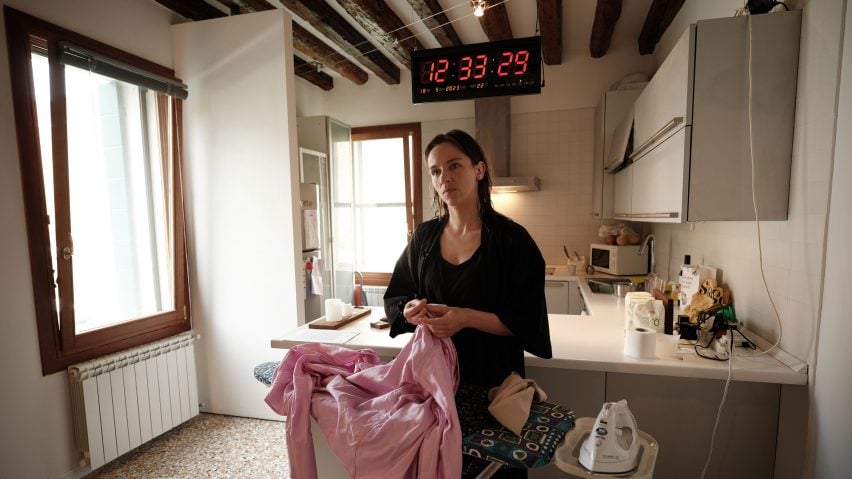The Estonian pavilion at this year's Venice Architecture Biennale is a rental apartment with a live-in actor who is performing daily rituals to explore the challenges of home ownership.
Titled Home Stage, the exhibition challenges the contradiction of a home being both a living space and a piece of real estate.
For nine months, different actors will each spend a month living in the apartment, carrying out both scripted and unscripted performances that explore tensions between these two functions.
The first resident is Arolin Raudva, who is spending her days making replicas of visitors' keys, meditating, playing board games with visitors, cleaning up and reading.
The apartment also contains a series of installations that pose different questions about the housing market, from an empty room to a bathroom fountain.
For curators Aet Ader, Arvi Anderson and Mari Möldre, all architects at Tallinn-based studio B210, the backdrop to the project is Estonia's lack of housing policy and high rates of home ownership.
"In Estonia, around 80 per cent of people own their homes," explained Ader during a tour of the exhibition.
"That means that we, the younger generation, are facing a lot of questions," she told Dezeen. "With a very small rental market and a vast amount of homeownership, what do we do?"
Located on Salizada Streta, a residential street close to the biennale's Arsenale venue, the exhibition is divided up into six different zones.
In the hallway, a series of boxes are coloured red and green, and arranged like a bar chart. They allude to the idea of moving house but also suggest units of value.
The living room features a shelving wall designed to look like a spreadsheet, filled with objects that include both real and fake plants, and box files with labels including "bills", "dreams" and "ideals". The adjoining dining area features a window that has been turned into a pendulum clock.
"When we are talking about real estate, time is a very important component," explained Ader.
In the kitchen, every object is marked with units of measurement so that all volumes can be kept track of. The idea was for the room to feel like a data store.
A mirror installation was fixed to the ceiling in the bedroom, allowing those lying in bed to see the view of the canal without turning their head. This nods to the value that a view adds to property.
The bed sheets were embroidered with a list of names, laid out in a neat grid that also resembles a spreadsheet, while a nightstand is a safe intended to raise concerns about privacy.
One room is empty, with dust clouds on the floor, in reference to properties that are bought as investments and not rented out, in order to keep their value.
In the bathroom, water playfully squirts across the room as if it were a leak, but lands in the bath. This highlights questions about maintenance and smart home systems.
The curators hope visitors will find the topic resonates with housing issues around the world.
"The contrast between home and real estate embodies a variety of human relationships and contradictory situations: depending on our role, the attitude towards spaces and people around us also changes," they said.
"The resulting creative mess in the Venetian apartment does not give finite answers but invites imagination and provokes critical thinking."
Other notable national pavilions at this year's Venice Architecture Biennale include Brazil's, which is filled with earth, and Finland's, which declares the death of the flushing toilet.
Dezeen is live reporting from the Venice Architecture Biennale, which takes place from 20 May to 26 November 2023. See Dezeen Events Guide for all the latest information you need to know to attend the event, as well as a list of other architecture and design events taking place around the world.

